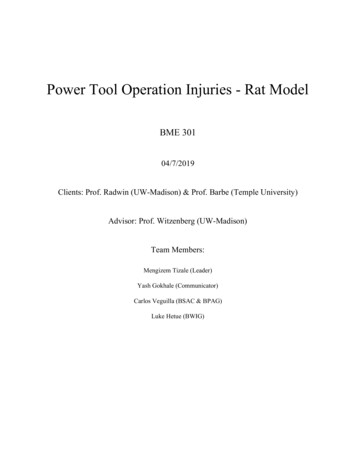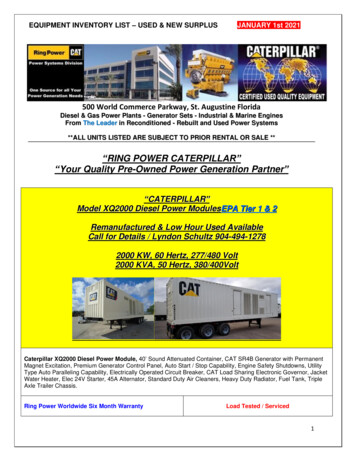
Transcription
Power Tool Operation Injuries - Rat ModelBME 30104/7/2019Clients: Prof. Radwin (UW-Madison) & Prof. Barbe (Temple University)Advisor: Prof. Witzenberg (UW-Madison)Team Members:Mengizem Tizale (Leader)Yash Gokhale (Communicator)Carlos Veguilla (BSAC & BPAG)Luke Hetue (BWIG)
1AbstractOur team assisted in our clients research on the effects of industrial power tools and theircause of workplace musculoskeletal disorders (WMSD’s). Our project proposes to use rats asanalogous models to better understand these injuries. We created a device which provideseccentric loads to the rats. This system is a dynamic system that involves a linear actuator and aload cell that apply and measure forces respectively. A novel circuit was implemented by ourteam to control the device and a mount was fabricated to match current specs of the client’s staticsystems. We found the performance of the circuit to be robust. However, the tests were donewith a replacement linear actuator since the desired linear servo and its microcontroller were notreceived on time. The team looks to implement the chosen linear servo and have a workingsystem of the desired size soon.
2Table of ContentsAbstract1Introduction3Motivation3Existing Devices4Problem Statement5Background5Biology and Physiology5Current Model6Client7Design Specifications7Preliminary DesignsDesigns ConsideredPreliminary Design Evaluation8810Design Matrix10Matrix Criteria10Final Design11Fabrication & Development ure Work19References20Appendix A - Preliminary PDS21Appendix B List of Materials27Appendix C Circuitry30Appendix D Testing Protocol31
3IntroductionThis semester, the team is continuing its work on the design of a device that can simulatethe use of power hand tools in rats. This work will be used to study the effects of repetitive useof industrial power hand tools like threaded fastener tools that create large impulses experiencedby the user. Over time, these forces can cause chronic injuries.The design will be a variation of an already existing device that can measure static forcesapplied by rats. This device will require rats to hold onto it and withstand the dynamic forcesintroduced by a linear actuator into the system for a desired period of time designated by theresearcher.The current objective of the team is to design a device while taking into account electricaland physical constraints. Eventually we will build a working apparatus to be used in research.MotivationToday the workplace’s leading cause of pain, suffering, and disability is work-relatedmusculoskeletal disorders (MSD’s) [1]. The Occupational Safety and Health Administration hasattributed them to possibly over 600,000 injuries and illnesses. This in turn accounts for 34% ofall work days lost according to the Bureau of Labor Statistics and costs up to 20 billionannually in direct workers’ compensation in addition to its even greater indirect costs. The focusof this project pertains to those MSD’s that have to do with the arm and wrist. These cases arefound especially in fields that require repetitive motion and exertion of the arm [2].
4The exact causes of these disorders are not well known. So much so, that in the 2010National Manufacturing Agenda of the National Institute of Occupational Safety and Health, itwas recommended that biomechanical research be put into the cause of MSD’s [3]. The focus ofthe project is to begin conducting tests on rats that will accurately replicate the use of powertools and hopefully induce MSD like symptoms to eventually analyze.Existing DevicesThis design will be the next step to an already existing device. Currently there is anapparatus that measures static forces applied by trained rats. Rats are kept in an 10” x 12” x4.75” acrylic box that has a small hole (2.5” x 0.4”) located such that the rats are only able to usetheir front right limbs during testing [4]. There is a handle that is located 0.75” outside of thehole that the rats have successfully been trained to pull. The research conducted had anincreasing regiment that required rats to pull harder over time in order to receive food pellets.This design and testing method has proven the efficacy of using an isometric pull test on rats totrain them while also collect data. The proposed design will change the static nature of thecurrent device into a dynamic one.Problem StatementWe aim to develop a device that contains a handle that a rat can be trained to pull whichinitiates a controlled rapid impulse force in the opposite direction that results in eccentric musclecontractions in the rat's arms, simulating repetitive power hand tool operation. The device mustbe adjustable so that trained rats can progress throughout the study. Both required force and
5duration of pull should be able to be manipulated. The device will be mounted on a base that fitsinto the space available beside the current cage set up to replace the static measuring system.BackgroundBiology and PhysiologyMusculoskeletal disorders (MSD’s) are injuries or pain that affect the musculoskeletalsystem of the body. This system is comprised of your bones, muscles, tendons, and ligamentsand is controlled by your nervous system that is intricately woven throughout it. MSD’s stemfrom nerve damage that affects other components of the musculoskeletal system.Nerves that innervate the upper extremity leave the spinal cord in what is known as thebrachial plexus, a complicated intertwining of nerve fibers, roots, and bundles [5]. These nerveswill eventually form your medial, radial, and ulnar nerves that run down your arm and are themain source of feeling in your upper extremity. If these nerves are damaged in any way, loss ofstrength and feeling will occur. Repetitive motion can cause these nerves to become compressed,also referred to as being entrapped, thus compromising them and causing an MSD.It has been shown that workers in many different fields that include repetitive tasks areaffected by MSD’s [6]. When it comes to working with industrial power tools we are concernedabout the bone of the upper extremity. Bone structure can be manipulated by repetitive loadingof the tissue [3][7]. With an increase in loading impulses generated by industrial power tools, itcan be assumed that these tools would cause changes to the makeup of the underlying bones.
6This change in makeup could be a cause to increases in chronic injuries. For example, bones ofpatients with MSD’s were scanned and found to have increased blood flow and blood pooling[3][8]. This could mean the bone is inflamed and this in turn could put the subject at higher riskof injury. In a related study, it was found that forestry workers who were exposed to hand-armvibrations were more prone to MSD’s then those who just did manual labor in the same field [8].Current ModelThe current device is known as the Vulintus Mototrack seen in Figure 1. The researchteam at Temple University currently runs its investigations using it. The Mototrak is a completesystem that includes a cage, controller, behavior module, pellet dispenser, auto positioner, andthe MotoTrak software. This system is currently a static system. It only measures a forcegenerated by a rat that pulls on a handle. Figure 2 shows the progression of a rat pulling on thehandle.Figure 1 - Vulintus Mototrack:This is the Vulintinus Mototrack with the cage,controller, and pellet dispenser. Dimensions arebeing provided to show size of the cage and space.Figure 2 - Rat reach, grasp, pull:This series of images shows the progression of a ratreaching for, grasping and then pulling on a handle in thecurrent device set up.
7ClientOur clients are Dr. Radwin and Dr. Barbe. Dr. Radwin works in industrial and SystemsEngineering as well as Biomedical Engineering at the University of Wisconsin - Madison. Hisinterest in research deals with injuries that occur in the industrial workplace. Dr. Radwin workswith a team at Temple University lead by Dr. Mary Barbe on this project. The research team atTemple University currently houses the rats and runs the investigations.Design SpecificationsThe client requests a device which provides an opposing force to the rat’s pull. Therewill be forces applied to the rats through a linear actuator. Also, reach duration should be able tobe changed by the researcher. The opposing force should begin immediately once the rat beginsto pull on the handle. The rat must retain it’s grasp on the handle for a given amount of time inorder to receive it’s food (the food should not fall out immediately once the rat pulls on thehandle). The threshold reach duration should range from 25 to 250ms (rat should hold on untilforce threshold is reached).
8Preliminary DesignsDesigns ConsideredNippon Linear ActuatorThis Nippon Linear Actuator, shown in Figure 3, has the ability to provide a continuousforce of 1.8 N which is sufficient for our application as the test specimens are able to apply onaverage 1.5 N. In addition to the favorable force output the Nippon actuator is very compact witha length of 8.5 cm makes it an ideal size to fit into the rat cage. An additional benefit of thisoption is that it offers a large input range from 10 - 240V can allow for a large degree ofadjustability when it comes to varying the speed. The main drawbacks of this option is the priceof 431 and that the company, Nippon, has proven difficult to work with, it took almost twoweek to be given the price for the actuator.AMD L12 Linear ServoFigure 4 shows the AMD L12 Linear Servo. This option offers equivalent force output inboth tension and compression, which will be important in our future work for further simulation
9of the effect of power tool use The servo capabilities of the L12 are also an attractive quality asit allows for easy speed control (via pulse width modulation) and allows us to control the exactpositioning of the arm based on the voltage we drive into its signal input. . Finally, with acompressed length of 12.5 cm, the L12 will allow for enough room to be left in the cage to bepractical. The main drawback of the L12 option is the low maximum speed of 25 mm/s whichmaybe too low to effectively modulate the intended motion. An additional drawback is that thereis a limited range of input voltages (only 4.5 - 7.5V) which will limit the various velocitiesdesired to test different scenarios.Firgelli high speed linear actuatorFigure 5 shows the Firgelli high speed linear actuator.This option addresses the speed issues that may be required toeffectively simulate the high speeds of power tool operation. Thisissue however is that this option is large, length of about 25 cm,which make it too large to fit in the space provided without heavymodifications to the cage. In addition to a concern with sizethe actuator requires an input of 12V of direct current makingit unable to adjust the speed of the actuator.
10Preliminary Design EvaluationDesign MatrixActuatorS120Q NipponPulseAMD L12 ActuatorFirgelli High Speed ActuatorAdjustability(30)4/5 243/5182/512Cost (25)1/5 54/5203/515Size (25)5/5 254/5201/55Speed(20)2/5 82/585/520Total (100)626652Table 1 - Design Matrix: This design matrix compares 3 possible linear actuators.Matrix CriteriaAdjustability is the ability of our design to conform to the range of peak forces and ramptimes entered by our client. We weighted adjustability at 30 as it is the most important aspect ofour design to our client. We objectively measured adjustability for each linear actuator bycomparing the range of voltages over which the linear actuator can operate as this relates to therange of speeds the linear actuator can operate over which allows us to control how much forcewe apply to the rat. The S120Q had a range from 10-240V and thus proved to be the highestrated in this category.
11Cost is important to our design as the components we are considering are very expensiveand we need to ensure that the linear actuator we purchase is within our budget as the forcesensor and amplifier alone come out to nearly 800. The L12, while pricy, was the mostaffordable out of the three actuators.Size is defined as the ability of the actuator to fit into the dimensions of the spaceavailable for us to work in. Because the the total depth, width, and length we have to work withare set parameters we want to minimize the space the linear actuator takes up in order to ensurewe have space for the rest of the components of our design. The S120Q won in this category asits fully extended length was the shortest.Speed is defined as the maximum speed at which the linear actuator can move. This isimportant to our design as it correlates to the max force we can apply to the rats arm. We canalways slow down the actuators speed using pulse width modulation from our microcontroller,however we can not increase the max speed. The Firgelli actuator won in this category with amax speed of 23 cm/s.Final DesignAccording to our matrix evaluation the L12 actuator will be most appropriate to usebecause it minimizes cost while still providing sufficient adjustability and force.Based upon our choice of the L12 actuator, we then designed a base that would stabilizeit and bring the system up to the height the current system rests at. The line of action of thesystem needed to be 9.5 cm from the tabletop and needed to fit within the space between thecage and the wall which measured 20 cm. The base would be made out of aluminum and
12would support the L12 by the actuator sitting on top of it. The servo would be fixed in positionvia brackets provided by the manufacturer. Rigid bars between the load cell and actuator andfrom the load cell to the handle would provide enough support throughout the system. Thisallows us to use less material in our final design. The dimensions of the base and the finalassembly can be seen in Figures 6 & 7 respectively.Fabrication & Development ProcessMaterialsOur design will consist of a FUTEK LSB200 load cell as the force sensing element in ourdesign. We will also have a CSG110 amplifier in order to increase the resolution of the signalcoming from our sensor as the forces we are working with are very small. The signal coming outof the amplifier will then be sent to an Arduino microcontroller which will process the signal and
13determine if the linear actuator needs to be extended or retracted. The microcontroller willcontrol the linear actuator via an H-Bridge circuit by allowing the microcontroller to switch thepolarity of the voltage being applied to the L12 linear actuator. The H-Bridge circuit will alsoprevent excessive current from going through the microcontroller.MethodsWe will create our final design by following the following simplified procedure. We willfirst calibrate our force sensor. We will then directly attach our force sensor to the arm of thelinear actuator so that the axis of the load on the force sensor would be in line with the axis of thelinear actuators arm movement. We will then connect the Linear actuator to the H-Bridge and theforce sensor to the amplifier. The H-Bridge will then be connected to a PWM output of themicrocontroller and the amplifier to the analog input to complete the circuit.TestingThe team began testing with the calibration test. This test consisted of hanging variousweights from our load cell as shown in figure 8 below.
14The result of the calibration test will be discussed in the results portion of this report. Inaddition to the calibration testing, a proof of concept test was conducted. This test consisted ofrunning the program associated with the device and identifying if the code would output a“SUCCESS” if the force read by the load cell surpassed the ramping force threshold, set prior tothe commencement of the test, or “FAILURE” if the force dropped sufficiently below thethreshold. The proof of concept test was ran multiple times with varying loads to ensure that theresults would be consistent.The final test that was conducted was a durability test in which the device was shakenand flipped upside down as shown in figure 9 to ensure that the device would survive beingshipped to Temple University so that our client, Professor Barbe, may implement her own set oftests.Figure 9. Image taken during durability test.We plan to potentially implement further tests which are described in the testing protocolwhich is located in Appendix D.
15ResultsFor the calibration test, the calibration curve show in figure 10 was observed. From this test, themaximum force that could be read by our device was found to be 2.172 N, which ensures that all recordedforce values fall below the 5N maximum load of the load cell.Figure 10. Graph of the calibration curve obtained from the calibration test:Curve was used to calculated maximum recordable load as well as the conversion equation used in the code.The proof of concept tests resulted in successful determination between tests in which theprogram should have output “SUCCESS” and tests in which “FAILURE” were to be output. Below figure11 and figure 12 illustrate a success test and a failure test respectfully. The results of this test allowed forus to be certain that the device is functioning properly.
16Figure 11. Graph of a test resulting in “SUCCESS”:Force exceed the threshold for the entire time resulting in a successful testFigure 12. Graph of test resulting in “FAILURE”:The time scale stops at 250 ms validating the program has recorded the test as a failureThe durability test also resulted in a success. As shown in figure 9, the output of the LED displaysshowed that the device was still able to function after the abuse that the device had been subjected to. Theresult from this test validated that the device would be able to safely be shipped and still be able tofunction as expected.
17DiscussionImplicationsIf our design is successful in modeling repetitive motion injuries in rats our clients canthen study the effects of these injuries on the rats’ muscle tissue. Rats are model organisms forhuman beings in many aspects of biology and physiology, and by better understanding theseinjures in the rats, our client would be able to make connections to the progression of theseinjuries in humans. This research could eventually lead to a better understanding of the effectsand pathways of repetitive motion injuries in the workplace and help to create morecomprehensive guidelines for heavy machinery operation.ConsiderationsSome considerations we kept in mind as we progressed in the project were that weneeded to ensure that our product met the size requirements set in place by our client, and if weneeded to compromise on some aspects of our design, our client needed to know exactly howthis could affect her research. Because our clients research has implications on human health,any deviation from what our client expected our product to be capable of compared to what itactually could do could lead to incorrect conclusions being drawn and have an adverse effect onhealth policies.
18ConclusionFindingsOur client is aiming to model repetitive motion injuries in rats. Currently the design ourclient is using does not apply any force to the rats arm as it is pulling. Our client would like us tocreate a product which applies a dynamic load to the rats arm which will increase linearly,starting at zero load, over a time period (set by our client) to a peak load (also set by our client).From our previous work on the project we found that the best way to do this is by using a linearactuator controlled by a microcontroller to pull back on the rats arm and apply a force.Through the course of the semester, the group was able to implement a circuit that wouldallow for dynamic load testing. The current model utilizes a linear actuator which exceeds thesize requirements set in place by our client and thus future work would include implementationof the smaller a
annually in direct workers’ compensation in addition to its even greater indirect costs. The focus of this project pertains to those MSD’s that have to do with the arm and wrist. These cases are found especially in fields that require repetitive motion and exertion of the arm [2].











